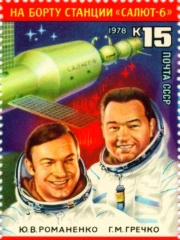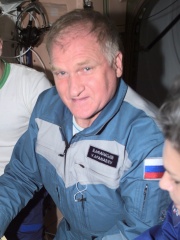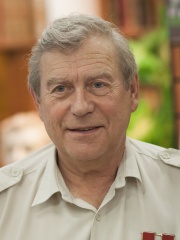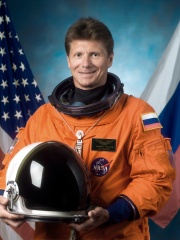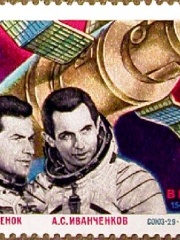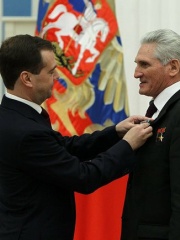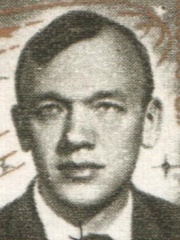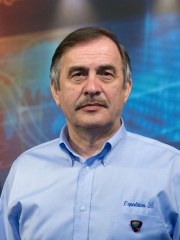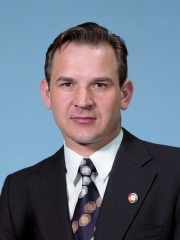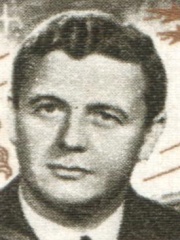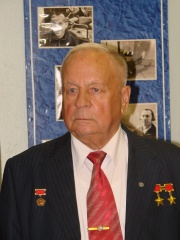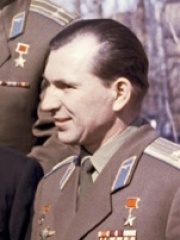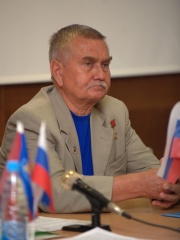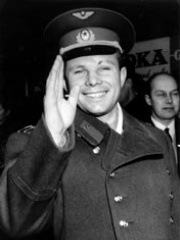
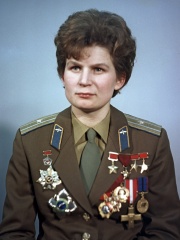
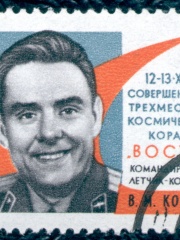
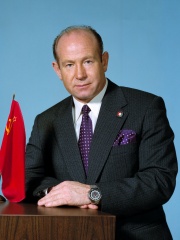
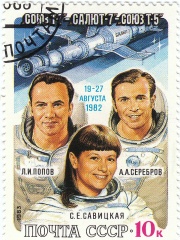
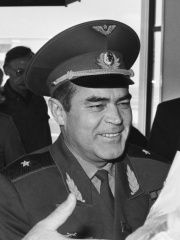
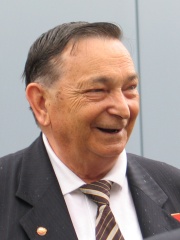
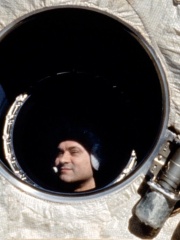
The Most Famous
ASTRONAUTS from Russia
This page contains a list of the greatest Russian Astronauts. The pantheon dataset contains 556 Astronauts, 84 of which were born in Russia. This makes Russia the birth place of the 2nd most number of Astronauts.
Top 10
The following people are considered by Pantheon to be the top 10 most legendary Russian Astronauts of all time. This list of famous Russian Astronauts is sorted by HPI (Historical Popularity Index), a metric that aggregates information on a biography's online popularity. Visit the rankings page to view the entire list of Russian Astronauts.

1. Yuri Gagarin (1934 - 1968)
With an HPI of 87.19, Yuri Gagarin is the most famous Russian Astronaut. His biography has been translated into 171 different languages on wikipedia.
Yuri Alekseyevich Gagarin (9 March 1934 – 27 March 1968) was a Soviet pilot and cosmonaut who, aboard the first successful crewed spaceflight, became the first person to journey into outer space. Travelling on Vostok 1, Gagarin completed one orbit of Earth on 12 April 1961, with his flight taking 108 minutes. By achieving this major milestone for the Soviet Union amidst the Space Race, he became an international celebrity and was awarded many medals and titles, including his country's highest distinction: Hero of the Soviet Union. Hailing from the village of Klushino in the Russian SFSR, Gagarin was a foundryman at a steel plant in Lyubertsy in his youth. He later joined the Soviet Air Forces as a pilot and was stationed at the Luostari Air Base, near the Norway–Soviet Union border, before his selection for the Soviet space programme alongside five other cosmonauts. Following his spaceflight, Gagarin became the deputy training director of the Cosmonaut Training Centre, which was later named after him. He was also elected as a deputy of the Soviet of the Union in 1962 and then to the Soviet of Nationalities, the lower and upper chambers of the Supreme Soviet respectively. Vostok 1 was Gagarin's only spaceflight, but he served as the backup crew to Soyuz 1, which ended in a fatal crash, killing his friend and fellow cosmonaut Vladimir Komarov. Fearful that a high-level national hero might be killed, Soviet officials banned Gagarin from participating in further spaceflights. After completing training at the Zhukovsky Air Force Engineering Academy in February 1968, he was again allowed to fly regular aircraft. However, Gagarin died five weeks later, when the MiG-15 that he was piloting with flight instructor Vladimir Seryogin crashed near the town of Kirzhach.

2. Valentina Tereshkova (b. 1937)
With an HPI of 80.96, Valentina Tereshkova is the 2nd most famous Russian Astronaut. Her biography has been translated into 112 different languages.
Valentina Vladimirovna Tereshkova (born 6 March 1937) is a Russian engineer, member of the State Duma, and former Soviet cosmonaut. She was the first woman in space, having flown a solo mission on Vostok 6 on 16 June 1963. She orbited the Earth 48 times, spent almost three days in space, is the only woman to have been on a solo space mission and is the last surviving Vostok programme cosmonaut. Twenty-six years old at the time of her spaceflight, she remains the youngest woman to have flown in space under the international definition of 100 km altitude, and the youngest woman to fly in Earth orbit. Before her selection for the Soviet space programme, Tereshkova was a textile factory worker and an amateur skydiver. She joined the Air Force as part of the Cosmonaut Corps and was commissioned as an officer after completing her training. After the dissolution of the first group of female cosmonauts in 1969, Tereshkova remained in the space programme as a cosmonaut instructor. She later graduated from the Zhukovsky Air Force Engineering Academy and re-qualified for spaceflight, but never went to space again. She retired from the Air Force in 1997 having attained the rank of major general. Tereshkova was a prominent member of the Communist Party of the Soviet Union, holding various political offices including being a member of the Presidium of the Supreme Soviet from 1974 to 1989. She remained politically active following the collapse of the Soviet Union but twice lost elections to the national State Duma in 1995 and 2003. Tereshkova was later elected in 2008 to her regional parliament, the Yaroslavl Oblast Duma. In 2011, she was elected to the national State Duma as a member of the ruling United Russia party and was re-elected in 2016 and 2021. She has the federal state civilian service rank of 1st class Active State Councillor of the Russian Federation. In 2022, she voted for the Russian invasion of Ukraine, which led to numerous international sanctions against her.

3. Vladimir Komarov (1927 - 1967)
With an HPI of 74.67, Vladimir Komarov is the 3rd most famous Russian Astronaut. His biography has been translated into 59 different languages.
Vladimir Mikhaylovich Komarov (Russian: Владимир Михайлович Комаров, IPA: [vlɐˈdʲimʲɪr mʲɪˈxajləvʲɪtɕ kəmɐˈrof]; 16 March 1927 – 24 April 1967) was a Soviet test pilot, aerospace engineer, and cosmonaut. In October 1964, he commanded Voskhod 1, the first spaceflight to carry more than one crew member. He became the first Soviet cosmonaut to fly in space twice when he was selected as the solo pilot of Soyuz 1, its first crewed test flight. A parachute failure caused his Soyuz capsule to crash into the ground after re-entry on 24 April 1967, making him the first human to die in a space flight. He was declared medically unfit for training or spaceflight twice while in the program but continued playing an active role. During his time at the cosmonaut training center, he contributed to space vehicle design, cosmonaut training, evaluation and public relations.

4. Alexei Leonov (1934 - 2019)
With an HPI of 71.15, Alexei Leonov is the 4th most famous Russian Astronaut. His biography has been translated into 76 different languages.
Alexei Arkhipovich Leonov (30 May 1934 – 11 October 2019) was a Soviet and Russian cosmonaut and aviator, Air Force major general, writer, and artist. On 18 March 1965, he became the first person to conduct a spacewalk, exiting the capsule during the Voskhod 2 mission for 12 minutes and 9 seconds. He was also selected to be the first Soviet person to land on the Moon although the project was eventually cancelled. In July 1975, Leonov commanded the Soyuz capsule in the Apollo–Soyuz mission, which docked in space for two days with an American Apollo capsule. Leonov was twice Hero of the Soviet Union (1965, 1975), a Major General of Aviation (1975), laureate of the USSR State Prize (1981), and a member of the Supreme Council of the United Russia party (2002–2019).
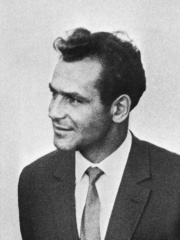
5. Gherman Titov (1935 - 2000)
With an HPI of 70.40, Gherman Titov is the 5th most famous Russian Astronaut. His biography has been translated into 56 different languages.
Gherman Stepanovich Titov (Russian: Герман Степанович Титов; 11 September 1935 – 20 September 2000) was a Soviet and Russian cosmonaut who, on 6 August 1961, became the second human to orbit the Earth, aboard Vostok 2, preceded by Yuri Gagarin on Vostok 1. He was the fourth person in space, counting suborbital voyages of US astronauts Alan Shepard and Gus Grissom. A month short of 26 years old at launch, he is the youngest professional astronaut and was the youngest person to fly in space until 2021 when Oliver Daemen flew on Blue Origin NS-16 at the age of 18. Since Daemen flew a suborbital mission, Titov remains the youngest person to fly in Earth orbit. Titov's flight finally proved that humans could live and work in space. He was the first person to orbit the Earth multiple times (a total of 17), the first to pilot a spaceship and to spend more than a day in space. He was also the first to sleep in orbit and to suffer from space sickness (becoming the first person to vomit in space). Titov was the first human photographer in space: he made the first manual photographs from orbit, thus setting a record for modern first photos of Earth from space by a human (the first picture of the planet from space was shot by a V-2 rocket in 1946, launched from New Mexico). He also was the first person to film the Earth using a professional quality Konvas-Avtomat movie camera, which he used for ten minutes. In his subsequent life Titov continued to work for the Soviet space program, and played a major role in the Spiral project where he trained to become the first pilot of an orbital spaceplane. However, after the death of Yuri Gagarin in a military aircraft accident in 1968, the Soviet government decided it could not afford to lose its second cosmonaut, and so Titov's career as test pilot ended. Titov served in the Soviet Air Force, attaining the rank of colonel-general. In his final years in post-Soviet Russia he became a Communist politician. Despite having been chosen second, after Gagarin, to fly into space, it was Titov who later proposed the Soviet Government regularly celebrate Cosmonautics Day on April 12, the day of Gagarin's flight.

6. Svetlana Savitskaya (b. 1948)
With an HPI of 67.55, Svetlana Savitskaya is the 6th most famous Russian Astronaut. Her biography has been translated into 65 different languages.
Svetlana Yevgenyevna Savitskaya (Russian: Светла́на Евге́ньевна Сави́цкая; born 8 August 1948) is a Russian former aviator and Soviet cosmonaut who flew aboard Soyuz T-7 in 1982, becoming the second woman in space. On her 1984 Soyuz T-12 mission she became the first woman to fly to space twice, and the first woman to perform a spacewalk. She set several FAI world records as a pilot.

7. Andriyan Nikolayev (1929 - 2004)
With an HPI of 66.54, Andriyan Nikolayev is the 7th most famous Russian Astronaut. His biography has been translated into 46 different languages.
Andriyan Grigoryevich Nikolayev (Chuvash and Russian: Андриян Григорьевич Николаев; 5 September 1929 – 3 July 2004) was a Soviet cosmonaut. In 1962, aboard Vostok 3, he became the third Soviet cosmonaut to fly into space. Nikolayev was an ethnic Chuvash and because of it considered the first Turkic cosmonaut.

8. Valery Bykovsky (1934 - 2019)
With an HPI of 65.88, Valery Bykovsky is the 8th most famous Russian Astronaut. His biography has been translated into 41 different languages.
Valery Fyodorovich Bykovsky (Russian: Вале́рий Фёдорович Быко́вский; 2 August 1934 – 27 March 2019) was a Soviet cosmonaut who flew on three space flights: Vostok 5, Soyuz 22, and Soyuz 31. He was also backup for Vostok 3 and Soyuz 37.

9. Valeri Polyakov (1942 - 2022)
With an HPI of 65.13, Valeri Polyakov is the 9th most famous Russian Astronaut. His biography has been translated into 46 different languages.
Valeri Vladimirovich Polyakov (Russian: Валерий Владимирович Поляков, IPA: [vɐˈlʲerʲɪj vlɐˈdʲimʲɪrəvʲɪtɕ pəlʲɪˈkof]; born Valeri Ivanovich Korshunov [Валерий Иванович Коршунов]; 27 April 1942 – 7 September 2022) was a Soviet and Russian cosmonaut. He is the record holder for the longest single stay in space, staying aboard the Mir space station for more than 14 months (437 days, 18 hours) during one trip. His combined space experience was more than 22 months. Selected as a cosmonaut in 1972, Polyakov made his first flight into space aboard Soyuz TM-6 in 1988. He returned to Earth 240 days later aboard TM-7. Polyakov completed his second flight into space in 1994–1995, spending 437 days in space between launching on Soyuz TM-18 and landing with TM-20, setting the record for the longest time continuously spent in space by an individual.
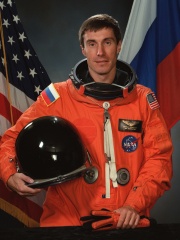
10. Sergei Krikalev (b. 1958)
With an HPI of 65.00, Sergei Krikalev is the 10th most famous Russian Astronaut. His biography has been translated into 37 different languages.
Sergei Konstantinovich Krikalev (Russian: Сергей Константинович Крикалёв; born 27 August 1958) is a Russian mechanical engineer and former cosmonaut. He is a veteran of six spaceflights, including two long-duration missions to Mir, two short-duration missions aboard NASA's Space Shuttle, and two long-duration missions to the International Space Station (ISS). On STS-60, he became the first Russian cosmonaut to fly on the Shuttle, and on STS-88, he helped connect the first Russian and American ISS segments—becoming, alongside mission commander Robert Cabana, one of the first people to enter the station. He later joined the ISS's first long-duration crew, Expedition 1, and returned as commander of Expedition 11. Krikalev is sometimes referred to as the "last Soviet citizen," having been aboard Mir during the dissolution of the Soviet Union. With the country that launched him no longer existing, his return was delayed, and he remained in space for 311 days—twice as long as planned. He ultimately accumulated 803 days, 9 hours, and 39 minutes in space, placing him fourth on the list of those with the most time spent in space. He retired as a cosmonaut in 2007 and then served as deputy chief designer at Energia, where he contributed to the development of Russian spacecraft. From 2009 to 2014, he headed the Yuri Gagarin Cosmonaut Training Center. Since 2014, he has worked for Roscosmos, Russia's space agency, where he is a Deputy Director General leading manned spaceflight efforts.
People
Pantheon has 84 people classified as Russian astronauts born between 1925 and 1977. Of these 84, 49 (58.33%) of them are still alive today. The most famous living Russian astronauts include Valentina Tereshkova, Svetlana Savitskaya, and Sergei Krikalev. The most famous deceased Russian astronauts include Yuri Gagarin, Vladimir Komarov, and Alexei Leonov.
Living Russian Astronauts
Go to all RankingsValentina Tereshkova
1937 - Present
HPI: 80.96
Svetlana Savitskaya
1948 - Present
HPI: 67.55
Sergei Krikalev
1958 - Present
HPI: 65.00
Yury Romanenko
1944 - Present
HPI: 61.43
Viktor Afanasyev
1948 - Present
HPI: 60.37
Aleksandr Pavlovich Aleksandrov
1943 - Present
HPI: 60.34
Gennady Padalka
1958 - Present
HPI: 60.33
Aleksandr Ivanchenkov
1940 - Present
HPI: 59.64
Boris Volynov
1934 - Present
HPI: 58.98
Aleksei Yeliseyev
1934 - Present
HPI: 58.67
Pavel Vinogradov
1953 - Present
HPI: 58.36
Valeri Tokarev
1952 - Present
HPI: 58.24
Deceased Russian Astronauts
Go to all RankingsYuri Gagarin
1934 - 1968
HPI: 87.19
Vladimir Komarov
1927 - 1967
HPI: 74.67
Alexei Leonov
1934 - 2019
HPI: 71.15
Gherman Titov
1935 - 2000
HPI: 70.40
Andriyan Nikolayev
1929 - 2004
HPI: 66.54
Valery Bykovsky
1934 - 2019
HPI: 65.88
Valeri Polyakov
1942 - 2022
HPI: 65.13
Valeri Kubasov
1935 - 2014
HPI: 64.50
Vladislav Volkov
1935 - 1971
HPI: 63.95
Viktor Gorbatko
1934 - 2017
HPI: 62.36
Pavel Belyayev
1925 - 1970
HPI: 62.29
Anatoly Berezovoy
1942 - 2014
HPI: 62.27
Overlapping Lives
Which Astronauts were alive at the same time? This visualization shows the lifespans of the 25 most globally memorable Astronauts since 1700.

